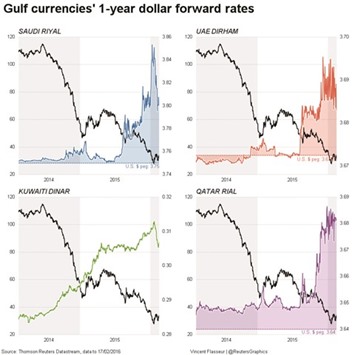Saudi Arabia headed a list of oil-producing nations whose credit ratings were cut by Standard & Poor’s on Wednesday amid the collapse in crude prices.
The country’s credit grade was cut two levels to A- from A+ as the decline in oil prices will have “a marked and lasting impact” on the economy of the biggest Opec producer. Oman’s was lowered to BBB- from BBB+, following a reduction in November. Kazakhstan is now rated BBB-, down from BBB, while Bahrain was lowered to BB from BBB-, putting it two steps below investment grade and the only one of the four to be rated junk.
The Saudi downgrade comes less than four months after S&P cut the kingdom’s credit rating one level to A+ in late October, when Brent crude was selling for around $50 a barrel. It settled at $34.50 a barrel in London on Wednesday. The agreement made this week among the world’s leading oil producers to curb production and revive prices won’t have a material impact on S&P’s crude price assumptions, the company said in a statement.
“The fact that Standard & Poor’s cut the ratings of a number of energy-exporting countries reflects the agency’s outlook on the price of oil,” Steve Hooker, who helps oversee $12.5bn of debt at Newfleet Asset Management in Hartford, Connecticut, said by phone. “Even though a slump in oil prices isn’t news to anyone, this sends a signal to the markets and adds to the nervousness regarding the prospects for Brent’s performance.”
Saudi Arabia’s growth in real per-capita gross domestic product will fall below that of its peers, while the annual average increase in the government’s debt burden could exceed 7% of GDP through 2019, according to the S&P statement. The outlook for the rating is stable, reflecting an expectation that the country “will take steps to prevent any further deterioration in the government’s fiscal position” the credit rating company said.
Since oil prices began to slide in 2014, pressure on Bahrain’s revenues has become “particularly acute” and the impact of the trend will “exacerbate existing structural frailty in Bahrain’s public finances, despite an active response from authorities,” S&P said.
Bahrain sold debt a day before the rating cut. The kingdom issued an additional $450mn of an existing bond due 2021 to yield 5.7% on February 16, along with $300mn more of an existing bond due 2026 to yield 7.4%.
The bond sale “this week will leave a bad taste in investors mouths though - with the sovereign getting in just ahead of the downgrade, and I think investors will remember that one,” Tim Ash, the head of emerging-market strategy at Nomura in London, said in a research note.
The rout in Brent crude is taking a toll on growth across the Arab world. Saudi Arabia, the largest economy in the region, is set to expand this year at the slowest pace since 2002 as the oil-price plunge drains the kingdom’s finances, according to projections from the International Monetary Fund and HSBC Holdings.
The downgrade of Saudi Arabia by two levels was “the most eye-catching” even if it was not a surprise, according Jason Tuvey, Middle East economist at Capital Economics in London. Central bank reserves declined $115bn in 2015 to $608bn and the budget deficit stood at about 15% of economic output last year.
“We don’t think the decision will have a major economic impact,” he wrote in a report. “The government has a strong balance sheet and the authorities have plenty of options with which to finance a large budget deficit,” he said. “An A- rating is good and still leaves Saudi Arabia as investment grade.”
Kazakhstan, the largest oil producer among former Soviet republics after Russia, was assigned a negative outlook by S&P, which cited uncertainty about the country’s monetary policies, accelerating inflation and a stagnating economy.

..
